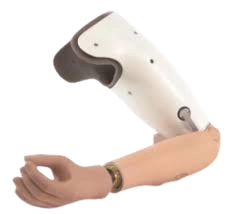Hand and arm prosthesis
Definition
 These are aesthetic prostheses created in collaboration with our partners specialized in the production of highly aesthetic prostheses in Tunisia and Europe). Prostheses can be fabricated for any level of amputation: from knuckle to partial hand amputation, to custom painted silicone cosmetic glove.
These are aesthetic prostheses created in collaboration with our partners specialized in the production of highly aesthetic prostheses in Tunisia and Europe). Prostheses can be fabricated for any level of amputation: from knuckle to partial hand amputation, to custom painted silicone cosmetic glove.
Cad\Cam prosthesis design
We have a complete CAD CAM system for the design and construction of positive models for the creation of sockets for lower limb prostheses and orthoses.
It is a complete system that allows us to acquire three-dimensional anthropometric measurements through fixed or portable equipment.
The three-dimensional images thus obtained are processed and transformed into a file readable by the computer which drives the CNC milling machine which creates the positive models.
The whole system results in a quality and speed of the creations of custom-made equipment superior to those made with the manual system (casting in plaster, processing the positive by hand).
In the last two years we have completely renewed the design software, also suitable for designing for 3D printing, the latest generation ultra-compact CNC milling machine and the photogrammetry digital acquisition scanner instant.
Arm prostheses
The first prosthetic devices involved the application of a particular envelope specifically designed on the individual, to surround and cling to the stump. The main drawback is discomfort: the hook, although well designed and adapted to the anatomy, often causes constriction, friction and pain, discouraging the use of the prosthesis. Moreover, these devices are set in motion only by the contraction of the residual biceps and triceps muscles, with predictable limits of force and precision.
In more advanced prostheses, on the contrary, "motors" have been inserted which carry out the movements by amplifying the signals from the muscles: the individual, trained to contract these muscle fibers, is able to activate a device which can finish with a hook, a clamp or a hand. What is still missing is a "feedback", that is to say a confirmation of the movement made: the person knows that he has succeeded in making a gesture because he sees it and hears the noise of the motors , but no responsive sensory stimulus comes from the limb prosthesis. A little as if, grabbing a cup of hot tea, we saw the hand in contact with the object but we did not perceive its weight in the hand and the heat on the skin.